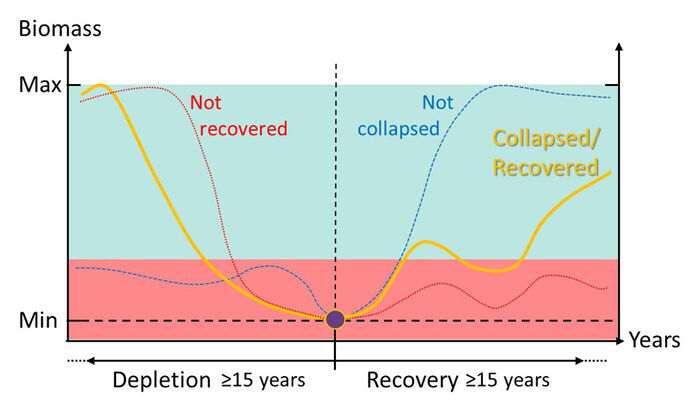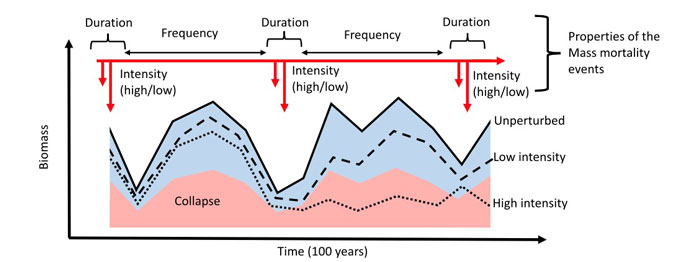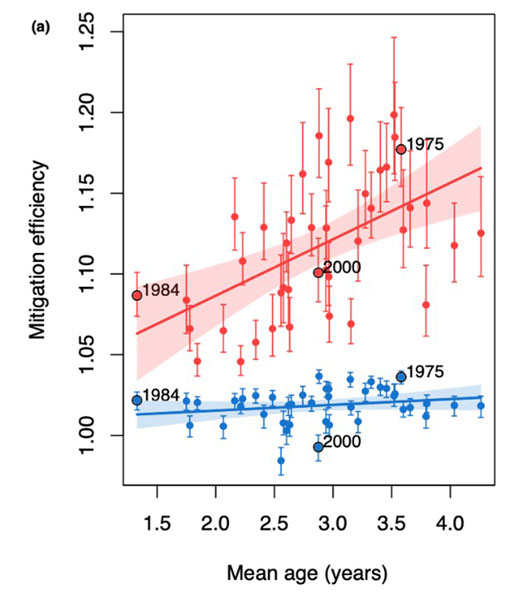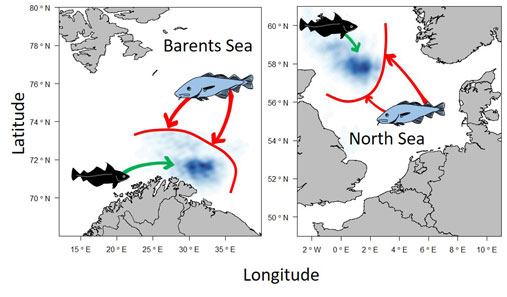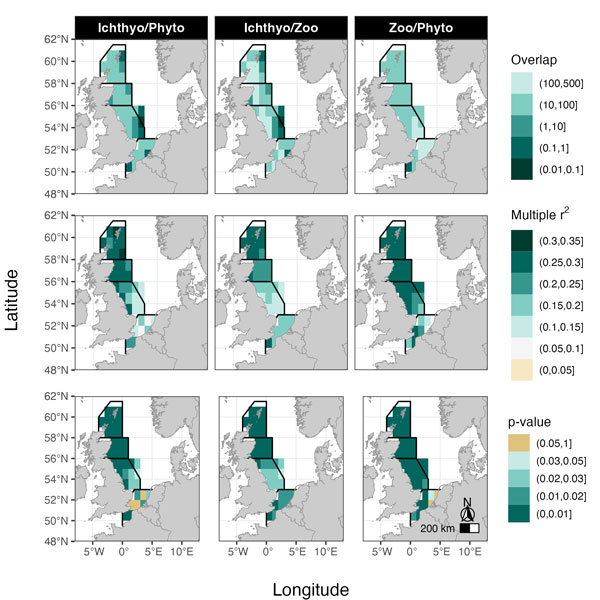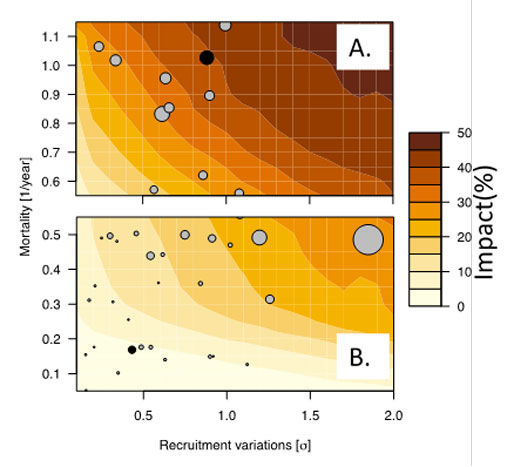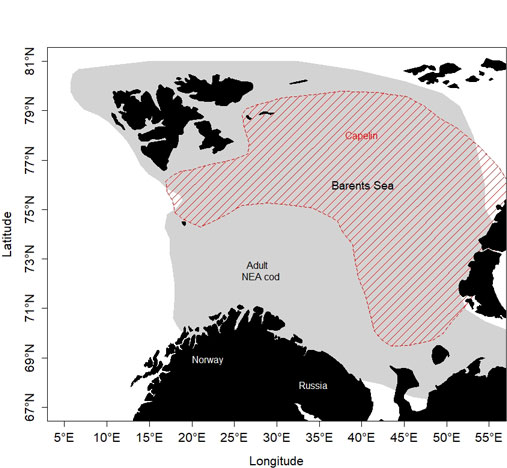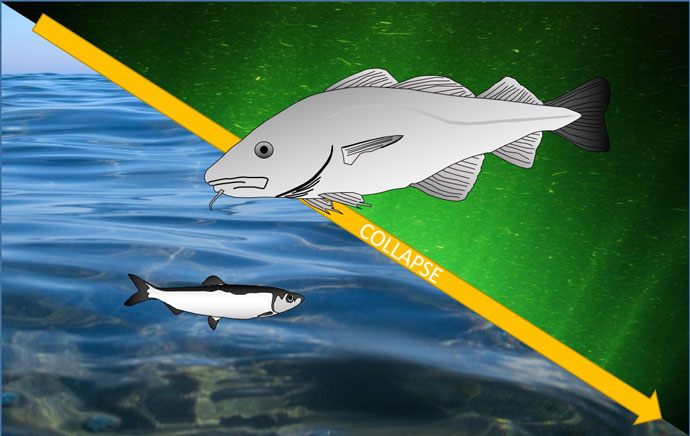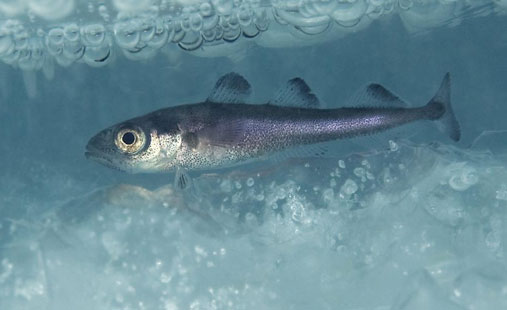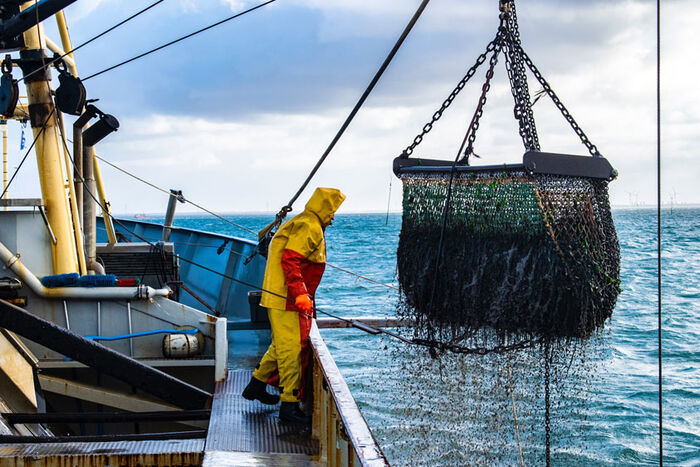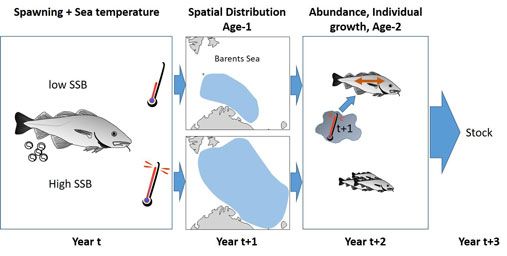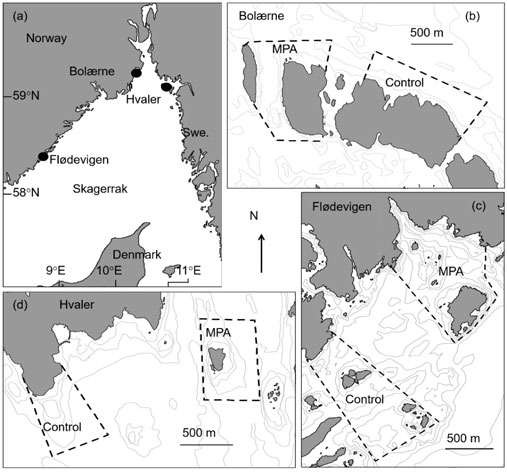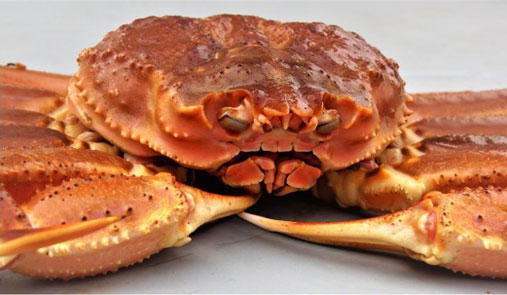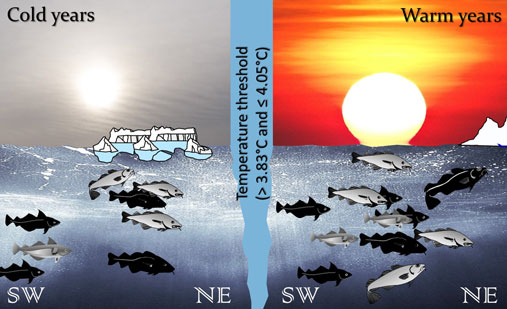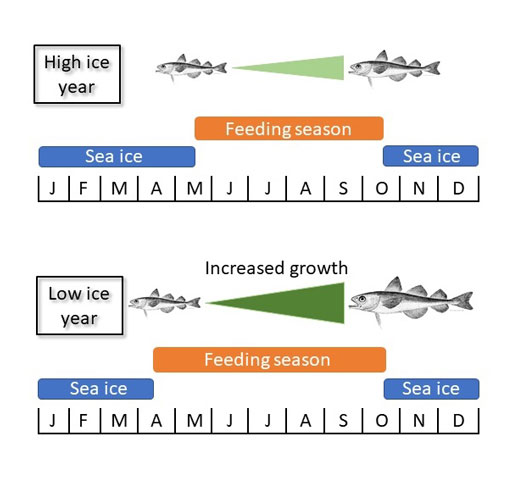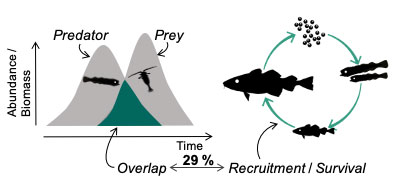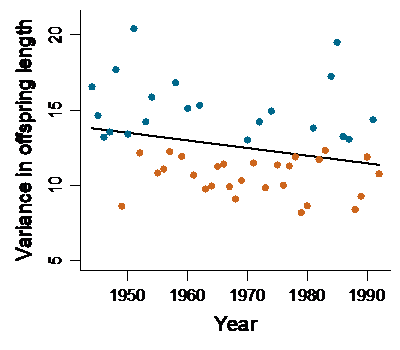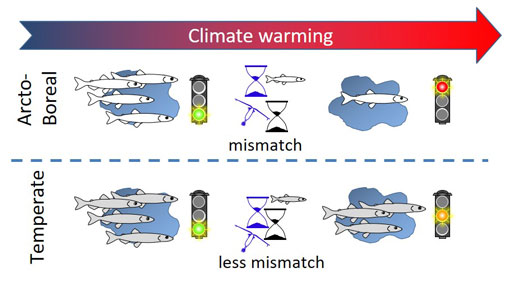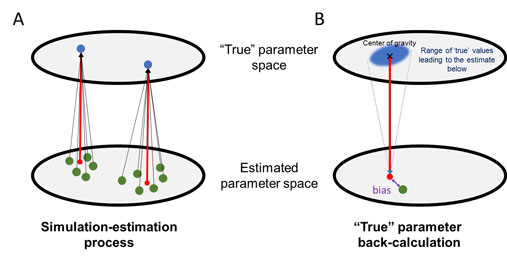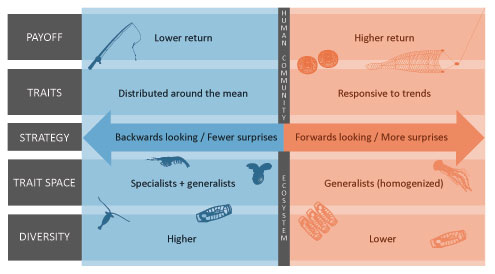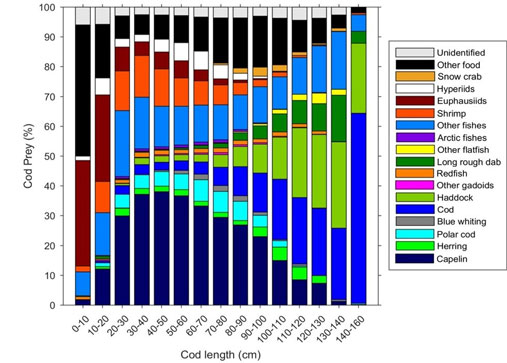The Norwegian coast is a spawning hot spot for several highly valuable fishes. After hatching, the young fish drift, largely together, toward the Barents Sea. During this drifting period, they need to feed and are experiencing predation. In a paper published in Marine Ecology Progress Series (Ferreira et al. 2024) we explore the benefits and disadvantages of drifting together with other larvae.
Blogs
The worldwide human footprint is increasingly evident. Over the decades, many species have collapsed or are collapsing with only some recovering. A key question is what happens to these populations after the collapse. In a study published in Scientific Reports (Durant et al 2024), we test whether the effect on fish populations from overfishing, climate, and survival of young fish remains the same after a collapse.
Extreme climate events, overexploitation and in general human activities can lead to a strong elevation of mortality, particularly for young and sensitive life stages. Such mass mortality events are predicted to occur more frequently. In our study published in Global Change Biology (Langangen & Durant, 2024), we recorded the chance of collapse of fish populations confronted to various levels and frequency of mass mortality events.
Climate change and increasing human activity are increasing risks of mass mortality events. In their recent study published in the Journal of Applied Ecology, Buttay et al. (2023) have focused on perturbations that could impact the early life stage of fish. Using the Northeast Arctic cod in the Barents Sea as an example, they evaluated different mitigation strategies alleviating the effect of such dramatic events on the population.
Climate is rapidly changing, with rising temperatures affecting various aspects of our environment. As our planet undergoes warming, numerous species are expected to expand their ranges in search of suitable habitats. In our recent study published in Ecology (Durant et al. 2023) we highlight the intricate relationship between climate warming, trophic interactions, and population expansion.
The Match-Mismatch Hypothesis (MMH) has been a fundamental concept in predator-prey studies for decades. In our recent study (Ferreira et al. 2023), we looked at the impacts of MMH on three trophic levels in the North Sea and found significant implications for sustainable fishery practices.
Mass mortality events are on the rise globally. However, we have a limited understanding of the population consequences of such events that particularly affect the early life of fish. To increase our understanding of the population-level effects of mass mortality in early life, we constructed population models for 40 fish species and ran scenarios on mass mortality for these species. Our approach allows for predictions of potential effects of mass mortality in a range of fish.
Understanding the changes in population abundance is essential to correctly manage and preserve the natural populations. Interaction between species, such as predation or competition, is an important factor affecting population dynamics. To understand population dynamics it is thus useful to study species interactions. In a recent study published in Biology Letters, we analysed the interaction between two iconic fish species of the Barents Sea: the capelin and the Atlantic cod.
Over the last century, overfishing has led to the collapse of many fish stocks. Some of them, following successful management actions, have rebuilt their number but did they remain the same? In a recent study published in Ecology and Evolution we explored the effect of collapse on the stocks ecology by testing for differences before and after.
Jellyfish are usually not targeted by scientific surveys that focus on commercial fish stocks. However, they are very often found in the by-catch of egg and larval surveys. In a recent paper in ICES journal of Marine Sciences, we studied such by-catch data from surveys conducted between 1959-1993 in the Barents Sea showing the high value of such historic data.
In the Arctic part of the Barents Sea, climate change is increasing temperature, melting the sea ice and bringing more predators. All these are a concern for the polar cod (Boreogadus saida) a key species in this food web. In a recent paper published in Marine Ecology Progress Series (Dupont et al. 2021) we explore which of these environmental factors has the most effect on polar cods.
“Social-ecological systems dependent on fisheries must be resilient or adapt to remain viable in the face of change.”
In a paper published in ICES journal of marine science we reviewed the adaptation options in fisheries management to support resilience and transition.
While the importance of early life survival and growth variations for population dynamics is well documented, there is still a relatively limited understanding of how survival and growth is affected by the species’ spatial distribution. In a study published in the ICES Journal of Marine Science, we analysed 24-years of indices of spatial distribution of 1 year old Northeast Arctic cod to study the role of distribution for the change in abundance and mean body size through their second winter of life.
Almost two decades of scientific monitoring of European lobster (Homarus gammarus) in Skagerrak confirm that Marine Protected Areas (MPAs) benefit the species’ local survival, but reveal geographic differences in lobster abundance that indicate not all MPAs are equal at reaching conservation goals.
The snow crab (Chionoecetes opilio) is a newly established species in the Barents Sea, increasing in both distribution and abundance in recent years. In this Arcto-Boreal sea, they encountered the most abundant Atlantic cod (Gadus morhua) stock. What happens from here?
In the Boreal-Arctic seas, the two most abundant gadoid fish are the Atlantic cod (Gadus morhua) and the haddock (Melanogrammus aeglefinus). Both tend to respond to climate warming by an abundance increase and a change of distribution. Are these changes affecting how they are interacting? Statistical analysis using a state-space threshold model of acoustic and trawl survey data on cod and haddock abundance indicates that the interaction is changing with sea temperature: the cod negatively affecting the haddock when sea temperature is over 4 °C.
We studied the effect of changes in sea ice cover, sea temperature, and biomass of prey or predator on the length of polar cod. Our results show a significant negative effect of sea ice cover on length of all age groups of polar cod: Polar cod grow faster when there is less sea ice.
We assessed the effect of the predator−prey relationship on predator survival by developing a novel metric of predator−prey overlap using spatio-temporal statistical models. We found that the amount of overlap between cod larvae (length: 11−15 mm) and their prey explained 29 % of cod recruitment variability.
In a recent study, we investigated the impact of size variations within cohorts and how this may affect the stability of cannibalistic populations. We found that large variations in size of the offspring tend to stabilize the population dynamics.
Climate warming is changing the timing of among others the reproduction for plankton or fish. Predators depend on an abundant prey supply to feed their young and insure that they survive. When the timing of the prey and the predator are not in synchrony the predator young cannot feed and are dying: there is a mismatch.
Conservation efforts and management decisions on the living environment of our planet often rely on imperfect statistical models. Therefore, managers have to brace for the uncertainty associated with the model and study system i.e., set their acceptable risk level, to make some decisions. However, risk estimates themselves can often be biased. In a recent paper published in Nature communications we demonstrate that one can back-calculate the correct value of risk by combining data fitting with an extensive simulation–estimation procedure.
A new pan-arctic study indicates that Calanus copepods do not necessarily descend deep for diapause in winter; instead, parts of the population remain active. Moreover, the deeper distribution of the larger and more conspicuous Calanus hyperboreus indicates that predation pressure is a key trigger for diapause at depth. In the central Arctic Ocean where visual predation pressure is lower, copepods might be relieved from the incentive to descend and can remain closer to the surface in winter.
Extreme events in the marine environment, like marine heatwaves, are likely at least as important as changes in mean values for causing threats to biodiversity, with impacts on ecosystem services and consequences for human systems. The potential of human and natural systems to adapt to such changes remains unclear, but two recent articles in the high-impact journal PNAS look closer at the possibilities.
Population abundance depends on production of young and survival of adults. Assessing the contribution of young production to population growth and identify the main drivers of its variability may help to identify appropriate stock management measures. What happens when several stocks, belonging to different trophic levels and habitats, as well as having different exploitation histories are sharing the same environment?
The Atlantic cod is one of the major predator in the Barents Sea estimated to consume over 5 million tonnes of fish in 2017. In a recent paper (Holt et al. 2019) we explore the diet of this species using a unique dataset encompassing 33 years of cod stomach sampling by Russian and Norwegian scientists. This time-series is the most comprehensive available cod diet dataset to date and is crucial in helping to answer ecologically important questions on what cod eat and why it matters for predator-prey and food-web dynamics in the Barents Sea ecosystem.

